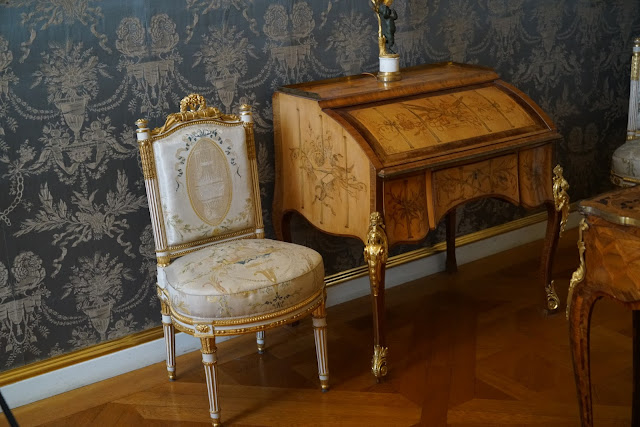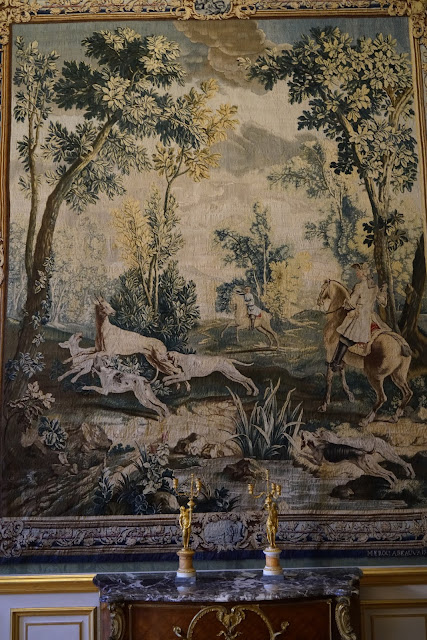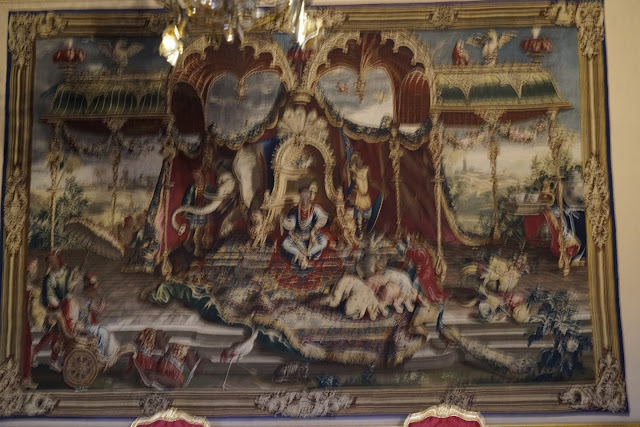I reached what was called the "Black Hall", built around 1590 by Duke Wilhem V. The hall got its name from 4 black scagliola portals erected in 1623. It got a painted ceiling which contains what appeared "real" architectural features, destroyed during the bombings in WWII and was only reconstructed in 1979 to the original design as done by Hans Werl in 1602.
The ceiling with "false" architectural features.
Then I walked quickly through what's called the "King's Tract" built by Ludwig I (reg. 1825-1848) which completes the south side of Residenz facing the Max Joseph Platz. The Tract was designed and built by architect Leo von Klenze in the neo-classical style and consists of various pieces of the King's and the Queen's chambers with steps leading up to them from opposite sides of the staircase and meeting in private room in the middle. They are now under renovation. So I only got this photograph of part what it would look like were that not so.
Various ceramics in oriental style in colors favored by European: blue and white
details of some of the items
In 17th Century Europe, blue and white porcelain vessels, jars, jars, vases, bowls and dishes were considered the epitome of china. In China, the porcelain fashion was transitioning from the much simpler Ming Dynasty (1268-1644) style of blue and white to that of the much more complex and multi-colored Qing style of red, yellow, green etc and huge quantities of blue and white porcelain favored by Europeans were exported from China especially during the reign of Emperor Kangzi (1662-1722) .
In the 17th Century, Chinoiserie like porcelain, lacquerware and silks from China and Japan became very fashionable amongst European nobility. When porcelain items reached Europe, some of them were gilded with bronze, silver or gold to make them look more precious. Often the typically egg-shaped Chinese vases for incense were transformed and some of the lids of the jars were changed to become European style covered goblets. Sometimes the body of the vase was cut into two and the upper parts fitted with new European style lids. This is a piece European porcelain imitating the Chinese style. Some merchants in the late 17th century Europe even bought plain Chinese plates and other items and then painted them more popular European patterns and figures and refired them before introducing them into the market.
Some gilded porcelain plates.
Some of the gilded bottles with European style lids
 Often plates used as decorations stories from Chinese drama. This one with 25 scenes were taken from a famous Romance of the Western Chambers ( 西廂記 ) of Yuan Dynasty about the secret love affair between the young scholar Zhang Sheng (張生), a young scholar, and Cui
Yingying (崔鶯鶯), the daughter of a Tang dynasty chief minister. The two
first meet in a Buddhist monastery and fell in love but Zhang could not express his feelings to her because she's closely watched by her mother except by reading aloud his love poem behind the wall of the courtyard close to Yingying's bedchamber. A local rebel general Sun Feihu (孫飛虎) has the monastery surrounded so that he can get Ying Ying as his wife. Yingying's mother then agrees that if Zhang drives the bandits away, he can have
Yingying. Zhang Sheng then rescues her with the help of his childhood friend General Du 「白馬將軍」蒲州杜太守 but Yingying's mother regrets her rash promise and refuses to let the two young lovers marry becauseshe thought Zhang too poor and status-less. Knowing that the two pine for each other, Yingying's maid, Hong Niang ( 紅娘) takes pity on them and
ingeniously arranges for them to get together in secret and then Yingying's mother reluctantly agrees to their marriage but only if Zhang passes the civil service examination. Zhang Sheng proves himself a brilliant scholar and was appointed a high official and the two finally got married.
Often plates used as decorations stories from Chinese drama. This one with 25 scenes were taken from a famous Romance of the Western Chambers ( 西廂記 ) of Yuan Dynasty about the secret love affair between the young scholar Zhang Sheng (張生), a young scholar, and Cui
Yingying (崔鶯鶯), the daughter of a Tang dynasty chief minister. The two
first meet in a Buddhist monastery and fell in love but Zhang could not express his feelings to her because she's closely watched by her mother except by reading aloud his love poem behind the wall of the courtyard close to Yingying's bedchamber. A local rebel general Sun Feihu (孫飛虎) has the monastery surrounded so that he can get Ying Ying as his wife. Yingying's mother then agrees that if Zhang drives the bandits away, he can have
Yingying. Zhang Sheng then rescues her with the help of his childhood friend General Du 「白馬將軍」蒲州杜太守 but Yingying's mother regrets her rash promise and refuses to let the two young lovers marry becauseshe thought Zhang too poor and status-less. Knowing that the two pine for each other, Yingying's maid, Hong Niang ( 紅娘) takes pity on them and
ingeniously arranges for them to get together in secret and then Yingying's mother reluctantly agrees to their marriage but only if Zhang passes the civil service examination. Zhang Sheng proves himself a brilliant scholar and was appointed a high official and the two finally got married.
A set of two plates with almost identical paintings
Another set of two plates from the same kilns with figures symbolizing luck, good fortune, wealth, health and flowers like the peony representing spring and love and chrysanthemum representing autumn, success and moral purity.
Porcelain in the transitional period between the Ming and Qing Dyansties depicting a scholar.
During the transition from Ming to Qing, China was marked by civil war and the china trade came to a standstill. To cope for the demand for porcelains European merchants began to turn to Japan which had been making porcelain since the 1600 and in around 1700, the porcelain from Imari (有田 ) of Kyushu (九州) exported from the town of Arita (有田町 ), much less expensive than those from Sakaida Kakiemon (酒井田柿右衛門) who learned the art of fine pottery from a Chinese potter at Nagasaki (長崎), with its lavish images in cobalt blue,red and gold which matched the taste of the Baroque era, became quite popular.
Tea set and plates from Amari
A lacqured paravent screen from China circa 1800 portraying the famous 10 Views from the West Lake (西湖十景)
A set of vases from Qing Dynasty, Kangxi (1662-1722) period. The Wittelsbach East-Asian porcelain collection totals more than 500 items of Chinese and Japanese porcelain acquired mostly around 1700 and can be seen on tables, commodes and mantelpieces in the Ornate Rooms and the Mirror Chamber.But there was not much understanding of the meaning of the various symbols in Chinese culture, thus the Chinese lions were often mistaken as "dogs" and the Quanyin was mistaken for the Madonna!
In the Netherlands and Germany, portrait miniatures were done in oil well into the 17th century but in Tudor England, a number of miniatures in body color were done on vellum and in the 18th century, miniature paintings flourished in France evoking the brilliant and elegant world of the Rococo. In the 19th century, the age of the middle class, they began to portray the inner life of the sitters in intimate family settings.
This is a portrait of the Nymphenburg Palace in the second antechamber, often used as a waiting room by visitors awaiting their audience with the Elector. On special occasions, the room is used as a dining room.
A portrait of Munich City including the Residenz in the second Antechamber
This is the Elector's Bedroom
Furniture in his room
A writing desk and chair from the "Blue Cabinet' so-called because of the color of its wall paper, a small room next to the Elector's bedroom.
Carved French cabinet and chairs from the bedroom of the Electress
Another French cabinet, not originally there
Its walls are decorated with damasks or reversible patterns as well as with tapestries
Another huge tapestry on the wall
This is the Electress' Audience Chamber which had only with a canopy, a throne and two commodes in the 18th century. The room was destroyed in 1944, during the WWII, but has since been rebuilt and refurnished in a more neutral style.
Tapestry on the wall of her Audience Chamber
More Tapestry from the Electress's 2nd Antechamber
The Courtyard of the Residenz


































沒有留言:
張貼留言